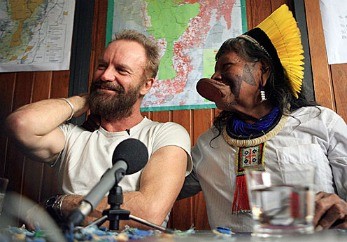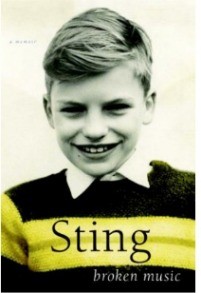
Glee star Matthew Morrison revealed this week that he is recording a duet with Sting, an announcement that thrilled middle-aged virgins worldwide but confirmed to fans of The Police that Sting's transformation from a wiry and literate songwriting innovator into a squinting, washed-up blowhard was finally complete.
Today we present a timeline charting Sting's 25-year decline from one of the only cool rock stars of the 1980s to his present state as the human embodiment of a Safe Word – a trusty, one syllable expression cried out when things get a little too dangerous or start moving a little too fast.
[
]
6. The Solo Record (1985)
If The Police soared on their sparse three-piece instrumentation, Sting's first solo record, The Dream of the Blue Turtles, collapsed under the creatine bulk of deliberately “soulful” (and therefore soulless) backing vocals, intrusive and needling horn blasts, and World Music rhythms endemic to rich white guys seeking midlife exotica.
This trinity of bad taste is most evident on the first single, “If You Love Somebody Set Them Free.” An early sign of Sting's creative dementia, the tune features a melody as elaborate as a Capn' Crunch jingle and redundant, commoner lyrics (“Free free, set them free”) hooted over a backdrop of Lite Jazz clichés.
Lest you think we're being harsh, keep in mind that a scant three years earlier with The Police, Sting niftily addressed the wasted potential and sinister yearnings of London commuters in “Synchronicity II” and in “King of Pain” effectively paired imagery of bejeweled royal corpses with an anthemic chorus.
Working on his own, he did this:
“Free free, set them free!”
Dream also included the schmaltzy synth number “Russians,” a stab at Cold War gravitas that today sounds like a discarded love theme from Rocky IV.
5. Political Activism (1986 to Present)

Like other well-meaning but pushy rock stars of his generation, Sting has supported a variety of causes over the years, such as Amnesty International in 1986, indigenous Amazon tribes in 1989, Walden Woods in 1991, and more recently, tsunami and Haiti relief efforts.
We're all for a celebrity using his muscle now and then to raise awareness, but for Sting, charitable work has become a compulsion. By hyping every imaginable cause in the last 25 years, Sting has guilt-tripped hundreds of other celebrities into the charity game. No big deal, right? Wrong.
Thanks to Sting's influence, even the most vacuous entertainers are gunning for some cause and routinely siphoning bandwidth from Twitter to promote everything from autism dissidence to Vegan diets despite a lack of expertise and a shameful unawareness that non-famous people don't have money to throw at random weirdo nonprofits.
Put another way – had Sting piped down 25 years ago and let a few rainforests get milled, guys like Ashton Kutcher would spend their free time lighting their farts, as they should be, rather than badgering the public to run half-marathons on behalf of brave people fighting bad diseases.
[
4. The Three Musketeers (1993)

By 1993, Sting was no longer content to distance himself from The Police and decided to openly mock anyone who ever liked them. Case in point, his collaboration with Bryan Adams (the Shame of Canada) and the perpetually sun-poisoned Rod Stewart for the soundtrack to Disney's The Three Musketeers.
Although other artists have turned out fine work for movie soundtracks (Prince on Purple Rain, Aimee Mann on Magnolia), Sting chose to enter the field by penning music for a throwaway blockbuster that starred Charlie Sheen and a flabby Kiefer Sutherland, who sported a diarrhea-colored mullet and beard.
The resulting song, “All For One,” sounded less like actual music than a contest between Sting and his smug pals to see who could carry a tune after huffing a lunch bag full of glue.
Inexplicably rocketing to number one, the song's success sadly did not encourage Sting to retire to an island but emboldened him to record even lamer Adult Contemporary music and to start sharing his so-called wisdom with the public.
3. Dubious Claims of Sexual Prowess (ca. 1996)

At some point in the mid-1990s, Sting reportedly claimed that Tantra meditation allowed him to bone wife Trudy Styler for up to 6 hours at a time, a claim that grossed out the public so much that it gained global, overnight infamy in the pre-Internet age.
Sting's credibility took a massive hit with this claim, not because anyone doubted that a properly medicated man can keep it up for 6 hours, but because no one believed that a guy could keep it up that long with Trudy Styler.
Sting would eventually claim the Tantra story was a joke, and we'd believe him, had he not continued to share the grody details of his sex life with journalists again and again and again.
And again.
And yet again…
[
2. Memoirs (2003)

Still narcissistic after all these years, Sting in 2003 released an autobiography, Broken Music, that completely skipped over his life in rock n' roll and focused instead on his childhood and his parents. Seriously. One of the biggest selling rock stars in history finally gets around to writing his life story and rather than throw his fans a few anecdotes about what a cheapskate Mick Jagger is or which A-listers have crabs, he delivers a Dickensian take on his own early years.
After leafing through 30 pages of Sting's humdrum memoirs, we almost started to miss his stories about boning his wife…almost.
1. Duet with Matthew Morrison (2011)

Congratulations, Sting! Trade in your Cultural Relevance chips at the cashier's window and take a seat in the Robert Goulet waiting room. Perhaps someday a young comedian will revive interest in your old music by doing an impression of you on SNL. Until then, enjoy the magazine selection. We have People, Parade, and Cosmo, which has a delightful article this month on finding a woman's second G-spot. We're sure you and the missus will love it.

